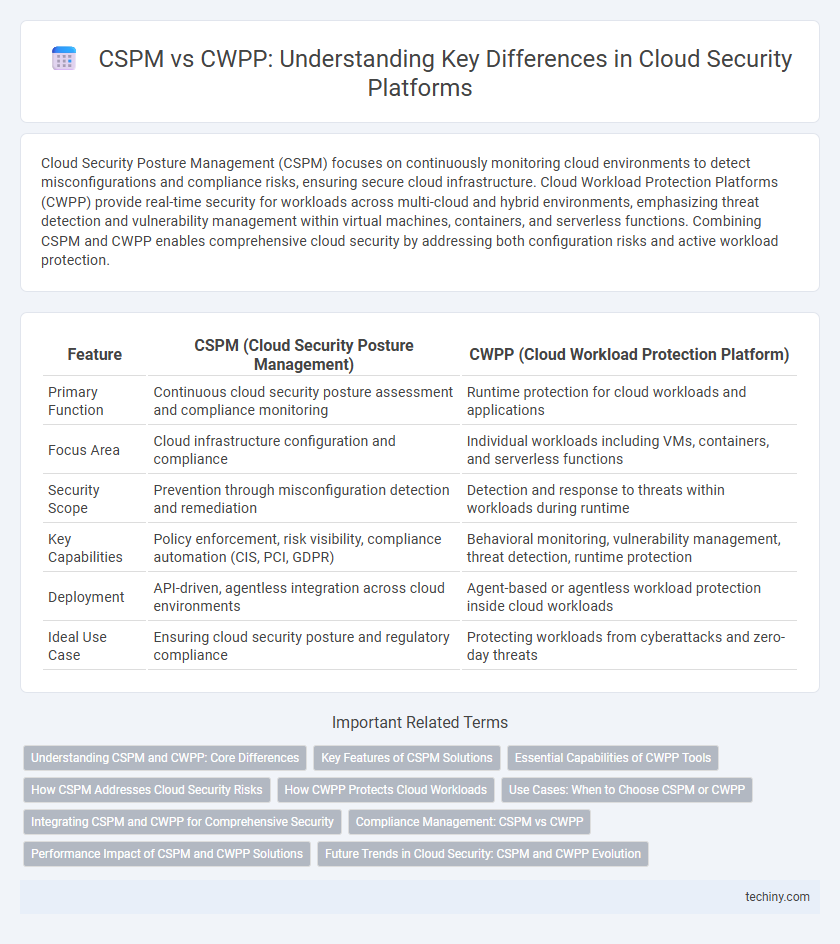Cloud Security Posture Management (CSPM) focuses on continuously monitoring cloud environments to detect misconfigurations and compliance risks, ensuring secure cloud infrastructure. Cloud Workload Protection Platforms (CWPP) provide real-time security for workloads across multi-cloud and hybrid environments, emphasizing threat detection and vulnerability management within virtual machines, containers, and serverless functions. Combining CSPM and CWPP enables comprehensive cloud security by addressing both configuration risks and active workload protection.
Table of Comparison
| Feature | CSPM (Cloud Security Posture Management) | CWPP (Cloud Workload Protection Platform) |
|---|---|---|
| Primary Function | Continuous cloud security posture assessment and compliance monitoring | Runtime protection for cloud workloads and applications |
| Focus Area | Cloud infrastructure configuration and compliance | Individual workloads including VMs, containers, and serverless functions |
| Security Scope | Prevention through misconfiguration detection and remediation | Detection and response to threats within workloads during runtime |
| Key Capabilities | Policy enforcement, risk visibility, compliance automation (CIS, PCI, GDPR) | Behavioral monitoring, vulnerability management, threat detection, runtime protection |
| Deployment | API-driven, agentless integration across cloud environments | Agent-based or agentless workload protection inside cloud workloads |
| Ideal Use Case | Ensuring cloud security posture and regulatory compliance | Protecting workloads from cyberattacks and zero-day threats |
Understanding CSPM and CWPP: Core Differences
Cloud Security Posture Management (CSPM) focuses on continuous monitoring and automated risk assessment of cloud infrastructure configurations to ensure compliance and prevent misconfigurations. Cloud Workload Protection Platforms (CWPP) prioritize real-time security for workloads by providing threat detection, vulnerability management, and runtime protection across virtual machines, containers, and serverless environments. Understanding these core differences helps organizations adopt a layered security approach that addresses both configuration risks and active workload threats in cloud environments.
Key Features of CSPM Solutions
Cloud Security Posture Management (CSPM) solutions continuously monitor cloud environments to identify misconfigurations, enforce compliance policies, and provide risk visualization, making them essential for maintaining cloud security hygiene. CSPM tools offer automated remediation, compliance reporting against standards like CIS, NIST, and HIPAA, and real-time alerts to prevent data breaches. Unlike Cloud Workload Protection Platforms (CWPP) that focus on workload-level security, CSPM emphasizes overall cloud infrastructure visibility and governance across multi-cloud environments.
Essential Capabilities of CWPP Tools
CWPP tools deliver essential capabilities such as runtime protection for workloads, vulnerability management, and application control across multi-cloud and hybrid environments, ensuring deep visibility and threat detection at the workload level. These tools focus on securing hosts, containers, and serverless functions by integrating threat intelligence, anomaly detection, and micro-segmentation to prevent lateral movement. Unlike CSPM, which prioritizes cloud configuration and compliance, CWPP offers proactive workload defense with features like behavioral analytics and automated response to sophisticated cyber threats.
How CSPM Addresses Cloud Security Risks
Cloud Security Posture Management (CSPM) continuously monitors cloud environments to identify misconfigurations and compliance violations, reducing risks such as unauthorized access and data breaches. By automating policy enforcement and providing real-time visibility across multi-cloud platforms, CSPM helps organizations maintain a secure cloud posture. Unlike Cloud Workload Protection Platforms (CWPP), which focus on workload-level security, CSPM addresses broader cloud infrastructure vulnerabilities and governance challenges.
How CWPP Protects Cloud Workloads
CWPP (Cloud Workload Protection Platform) secures cloud workloads through real-time threat detection, vulnerability management, and behavioral monitoring across virtual machines, containers, and serverless functions. It provides granular workload-level security policies that enforce compliance and mitigate risks from misconfigurations and zero-day attacks. Integration with CI/CD pipelines ensures continuous protection during the deployment and runtime phases, enhancing cloud infrastructure resilience.
Use Cases: When to Choose CSPM or CWPP
CSPM (Cloud Security Posture Management) is ideal for organizations prioritizing continuous compliance monitoring, misconfiguration detection, and governance across multi-cloud environments. CWPP (Cloud Workload Protection Platform) excels in securing individual workloads, such as containers, VMs, and serverless functions, by providing runtime protection, vulnerability management, and threat detection. Choose CSPM for cloud infrastructure visibility and compliance; select CWPP for in-depth workload security and threat response.
Integrating CSPM and CWPP for Comprehensive Security
Integrating Cloud Security Posture Management (CSPM) with Cloud Workload Protection Platforms (CWPP) delivers a comprehensive security framework by combining continuous compliance monitoring and workload-level threat protection. CSPM identifies misconfigurations and compliance violations across cloud environments, while CWPP secures workloads by detecting vulnerabilities, malware, and runtime anomalies. Leveraging both solutions enables organizations to achieve end-to-end visibility and proactive defense, reducing cloud risk and enhancing governance across multi-cloud infrastructures.
Compliance Management: CSPM vs CWPP
Cloud Security Posture Management (CSPM) enhances compliance management by continuously monitoring cloud configurations against regulatory standards such as GDPR, HIPAA, and PCI-DSS, ensuring automated remediation of misconfigurations. Cloud Workload Protection Platforms (CWPP) focus on protecting workloads at the host and application levels, integrating compliance by enforcing security policies specific to runtime environments and vulnerability management. CSPM excels in overall cloud environment compliance visibility, while CWPP provides granular, workload-specific compliance controls critical for dynamic and containerized workloads.
Performance Impact of CSPM and CWPP Solutions
CSPM (Cloud Security Posture Management) solutions generally have a minimal performance impact as they primarily monitor and assess cloud configurations for compliance and security risks without directly interacting with workloads. CWPP (Cloud Workload Protection Platforms) often involve real-time threat detection and behavioral analysis on running workloads, which can introduce latency and resource overhead depending on the deployment architecture. Optimizing the balance between security thoroughness and operational efficiency requires evaluating CSPM and CWPP performance impacts relative to specific cloud environments and workload types.
Future Trends in Cloud Security: CSPM and CWPP Evolution
Future trends in cloud security indicate significant evolution in CSPM (Cloud Security Posture Management) and CWPP (Cloud Workload Protection Platforms) with enhanced AI-driven threat detection and automated compliance enforcement. Integration of CSPM and CWPP capabilities is expected to provide unified visibility and comprehensive risk mitigation across multi-cloud environments. Advancements in real-time analytics and adaptive policy frameworks will drive proactive security measures, addressing increasingly complex cloud-native threats.
CSPM vs CWPP Infographic

 techiny.com
techiny.com